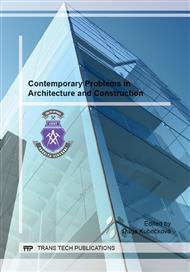[1]
G. Kouroussis, L. Van Parys, C. Conti, O. Verlinden, Using three-dimensional finite element analysis in time domain to model railway-induced ground vibrations, Advances in Engineering Software, 70 (2014), pp.63-76.
DOI: 10.1016/j.advengsoft.2014.01.005
Google Scholar
[2]
T. Petřík, M. Lednická, Z. Kaláb, E. Hrubešová, Analysis of Technical Seismicity in the Vicinity of Reconstructed Road. Transactions of the VŠB – Technical University of Ostrava, Civil Engineering Series. Volume XII, Issue 1, Pages 1–10, ISSN (Online) 1804-4824, ISSN (Print) 1213-1962, DOI: 10. 2478/v10160-012-0005-7, July (2012).
DOI: 10.2478/v10160-012-0005-7
Google Scholar
[3]
M. Pinka, M. Stolárik, Seismic Response Hydraulic Hammer on the Secundary Lining Tunnel. Transactions of the VŠB – Technical University of Ostrava, Civil Engineering Series. Volume XII, Issue 2, Pages 132–142, ISSN (Online) 1804-4824, ISSN (Print) 1213-1962, DOI: 10. 2478/v10160-012-0027-1, January (2013).
DOI: 10.2478/v10160-012-0027-1
Google Scholar
[4]
M. Stolárik, Modeling of Vibration Effect within Small Distances, Acta Geodynamica Et Geomaterialia, 5(2) (2008), 137–146.
Google Scholar
[5]
T. Petřík, E. Hrubešová and M. Lednická, A comparison of numerical models results with in-situ measurement of ground vibrations caused by sheet pile driving. Acta Geodynamica Et Geomaterialia, 9(2) (2012), pp.165-171.
Google Scholar
[6]
T. Petřík , E. Hrubešová , M. Stolárik , M. Pinka, Parametric study on the effects of soil to oscillation velocity, Transactions of the VŠB – Technical University of Ostrava, Civil Engineering Series. Volume XII, Issue 2, Pages 123–131, ISSN (Online) 1804-4824, ISSN (Print) 1213-1962, DOI: 10. 2478/v10160-012-0026-2, January (2013).
DOI: 10.2478/v10160-012-0026-2
Google Scholar
[7]
A.G. Chehab, M.H. El Naggar, Design of efficient base isolation for hammers and presses, Soil Dynamics and Earthquake Engineering, 23(2) (2003), pp.127-141.
DOI: 10.1016/s0267-7261(02)00157-4
Google Scholar
[8]
E. Rivin, Vibration isolation, applications and criteria, in: edited by S. Braun (Eds. ) Encyclopedia of Vibration, Elsevier, Oxford, 2001, pp.1507-1521.
DOI: 10.1006/rwvb.2001.0181
Google Scholar
[9]
C. Murillo, L. Thorel, B. Caicedo, Ground vibration isolation with geofoam barriers: Centrifuge modeling, Geotextiles and Geomembranes, 27(6) (2009), pp.423-434.
DOI: 10.1016/j.geotexmem.2009.03.006
Google Scholar
[10]
E. Çelebi, O. Kırtel, Non-linear 2-D FE modeling for prediction of screening performance of thin-walled trench barriers in mitigation of train-induced ground vibrations, Construction and Building Materials, 42 (2013), pp.122-131.
DOI: 10.1016/j.conbuildmat.2012.12.071
Google Scholar
[11]
D. Connolly, A. Giannopoulos, W. Fan, P.K. Woodward, M.C. Forde, Optimising low acoustic impedance back-fill material wave barrier dimensions to shield structures from ground borne high speed rail vibrations, Construction and Building Materials, 44 (2013).
DOI: 10.1016/j.conbuildmat.2013.03.034
Google Scholar
[12]
MIDAS/ GTS 2D Tutorial 14 on http: /midasuser. com.
Google Scholar
[13]
Information on http: /www. chinesehammers. com.
Google Scholar


